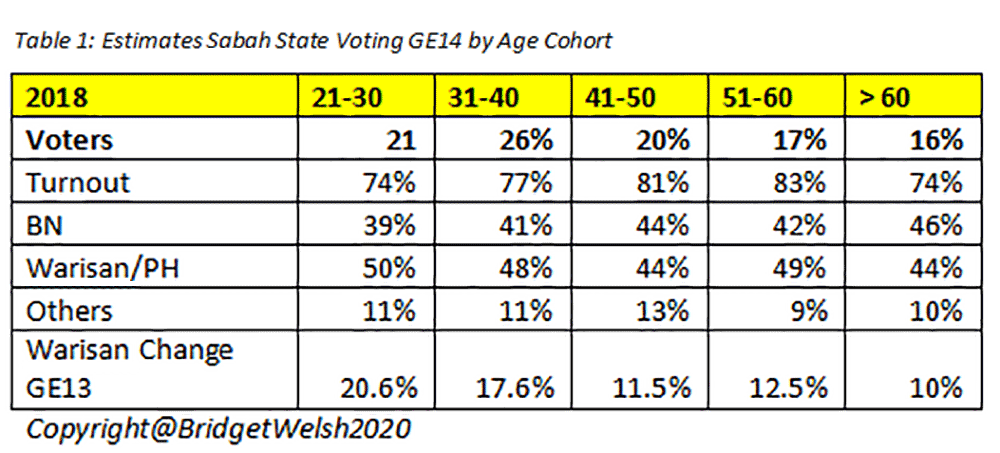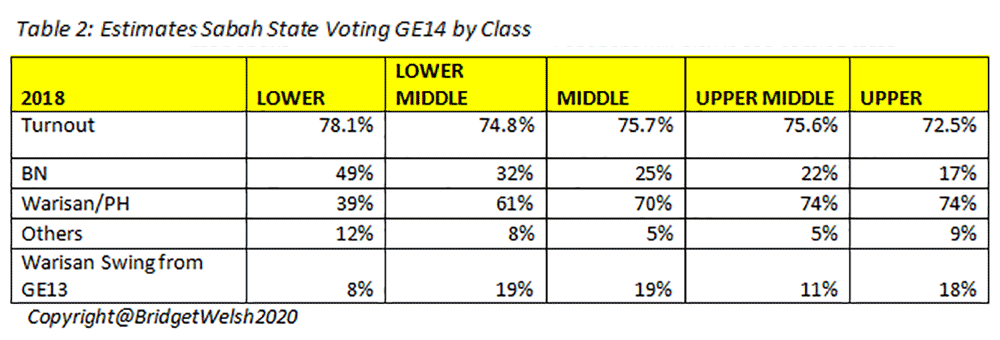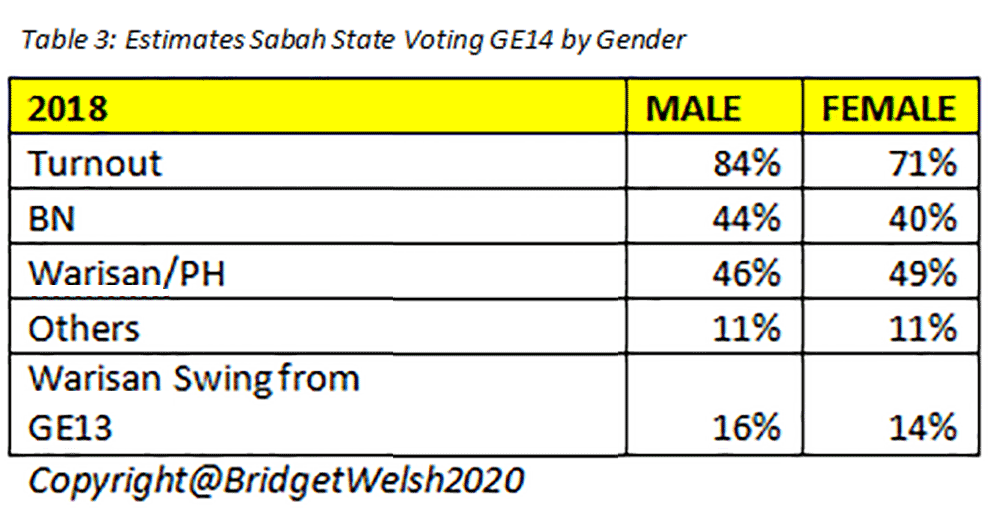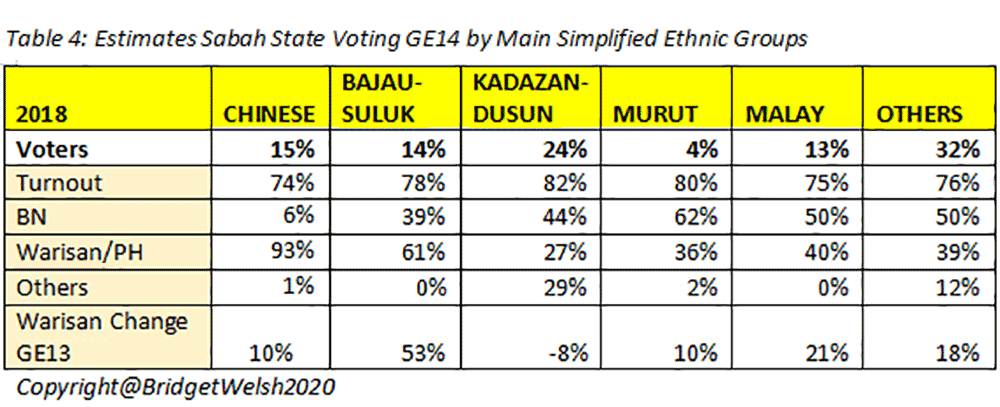
It is the final days of the Sabah campaign, every vote will count in these highly competitive polls. It is in this spirit of understanding that voting is valuable to look back at how Sabahans voted in the recent past.
GE14 was one of four intensely contested Sabah state elections (the others being held in 1985, 1986 and 1994). In all four of these polls, there was a swing away from the BN government. This article dissects the Warisan swing in 2018.
Scholarship on the GE14 Warisan electoral gains have highlighted three main drivers – 1) state rights: the strength of the state rights movement which Warisan was able to tap into as a state-based party; 2) resentment towards Umno’s Musa Aman, chief minister for 15 years; and 3) a broader call for change/reform: the effect of demands for ‘change’ across Malaysia led nationally by Pakatan Harapan against the leadership of now convicted former premier Najib Razak.
A look at voting behaviour patterns suggests that voting in Sabah both replicated national trends, but took on its own character, reflecting the state’s different political history and socio-economic conditions.
Drawing from statistical analytical estimates of results at the polling station level in state contests in the last two elections, a database developed of local communities, and the electoral roll composition at the polling station level, I lay out how four important social cleavages were an integral part of the 2018 election – generation, class, ethnic and gender differences.
Younger voters
Much has been written about the crucial role that younger Sabahans will play in the coming state election. While many of those under 30 have not registered to the same degree as older voters, with an estimated 22% of younger voters under 30 years of age not registered, how youngers voters participate in this 2020 poll will matter. They were instrumental in shaping the past and will shape Sabah’s future.
In GE14, estimates show that different age cohorts have different patterns of support, with Warisan and its allies winning a majority of voters under 30. The then opposition alliance also went head-to-head with BN across older age groups, winning a majority of the reformasi generation in their 50s and those under 40. The largest swing in support was among voters under 30.

These results in support levels reflect broadly similar trends in Peninsular Malaysia, especially the amount of the swing. In Peninsular Malaysia, the share Harapan won of younger voters under 30 in most areas was generally higher, beginning from a higher point from GE13.
One important dimension in the discussion is youth turnout. In GE14, it is was the lowest, but not by much. How many young people go home and return to vote will shape the outcome. It is not clear whether it will however reach GE14 levels of 74%. Warisan Plus is looking to maintain high support levels among younger voters, a reason that voter participation and turnout has been an integral part of their campaign.
Centrality of class voting
Much less understood and underrated is the role that class plays in voting in Malaysia. My study of national trends in GE14 found that class is an essential feature of voting behaviour, with changes in class support in GE14, especially among lower middle-class voters (monthly income estimated RM2,000-RM5,000) instrumental in the shift that occurred over two years ago. Also, wealthier voters also differ in their support from those less well-off, with more support for reform and change.
Acknowledging the challenges of assessing this indicator, the data tied to average income in areas suggests that Warisan/Harapan’s support was higher among wealthier voters in GE14 in Sabah – in line with national trends. Poorer voters with income less than RM2,000 stayed with BN, a coalition that has long used its resource advantage to secure the support of poorer voters.

GE14 in Sabah did see important swings across class levels, with lower middle/middle and upper classes - income levels between RM2,000-RM5,000/RM5,000-RM10,000 and above RM20,000 respectively - moving toward Warisan and its allies. The shifts among lower/middle-class voters (19%), as this involves a large share of voters and among the poorest voters (8%), given the high incidence of poverty in Sabah of 19.5% of households according to the 2019 Household Income and Expenditure Survey, were both impactful.
Nationally, BN lost power because more economically vulnerable voters abandoned them in high numbers. This also occurred in Sabah, to a lesser extent than elsewhere in GE14 but in large numbers. This campaign, the focus on Covid-19 aid in particular, has been an attempt to appeal to poorer voters to reduce Warisan support among the poorest segment of Sabah society.
Power of women
So far, Sabah differed in intensity in the GE14 national trends but generally followed the national pattern in voting. Where Sabah stands out uniquely is in how Sabah women vote. Findings show that women favoured the then opposition, Warisan, to a greater degree than men, a pattern that reverses the findings in Peninsular Malaysia. More women voted for Warisan and its allies compared to men. This was also the case in 2013.
The BN parties – notably Umno – lack the same level of support among women than they do in Peninsular Malaysia. The sexist comments of some BN leaders have alienated many women in Sabah, and plays a role in how women vote, along with the appeal to change. The BN parties also have comparatively less effective outreach to female voters.
Both men and women were part of the GE14 change. The gender swing towards Warisan in GE14 was modestly higher among men than women, but both swings were sizeable.
What is particularly relevant along gender lines is turnout. There is a serious gap in turnout by women, over 10% less women come out to vote than men. This is shaped by demands of family, the high cost of voting in Sabah in terms of accessing polling stations and inadequate outreach to women voters by all the political parties.
Women maintaining support and coming out to vote will be essential for Warisan Plus this Saturday – as based on voting patterns of support women in Sabah have been leading the push for change.

Last, but not least, are ethnic voting trends. My earlier pieces have repeatedly stressed the important of local identities. The findings detailed below amalgamate (and oversimplifies) important local ethnic differences in Sabah. That said, this framing allows trends along ethnic lines to be clearer.
We see that Bajau-Suluk support was the largest swing (53%) towards Warisan and its allies in GE14, followed by other Malay-Muslim groups (21%) such as Brunei Malays. The ‘Other’ category, smaller minorities (18%) involve many communities, including Bugis, for example, who are classified separately in the Sabah electoral roll. A sizeable shift towards Warisan (10%) occurred among Chinese and Murut voters.
Kadazan-Dusun support moved (8%) towards BN in GE14, over the issue of concerns with illegal immigrants, and mobilisation of fear of other ethnic communities in GE14. A similar trend was evident in the Kimanis January 2020 by-election. The Kadazan and Dusun communities also recorded the highest voter turnout, followed by the Murut.

Looking forward
The tendency is to focus on the last analytical frame in understanding voting – ethnicity. This is how issues were mobilised on the ground and framed in GE14 campaign. This lens predominates understanding of voting generally in Malaysia. This 2020 Sabah state election, while ethnic narratives are present, they blend with other messages of unity and concerns with federal interference. Contending identities are being pitted against each other.
All communities matter in Sabah. This is the reality of close contests. Chinese Sabahans have been traditional kingmakers, and still hold sway in almost half the seats, but Kadazan, Dusun and Murut voters will be important as well. Perikatan Nasional (PN) and BN are relying on divisions in these communities, and promoting its engagement with Malay and Bugis voters. Ethnicity remains a major mobiliser.
Behind ethnicity are other powerful social cleavages – generation, class and gender. In this election, these other cleavages may prove to be even more decisive in shaping the final outcome.
Warisan Plus will need to get its ‘swingers’ – the young, women, lower middle-class voters – to stay with them as well as assure those who helped them to secure victory – upper- and middle-class voters – remain loyal. Umno and PN are working hard to stop the Warisan momentum, as elites across Malaysia engage in an intensive contest to woo Sabahans and shape the state’s and national trajectory.
BRIDGET WELSH is a Senior Research Associate at the Hu Fu Centre for East Asia Democratic Studies and a Senior Associate Fellow of The Habibie Centre. She tweets at @dririshsea. - Mkini
The views expressed here are those of the author/contributor and do not necessarily represent the views of MMKtT.


No comments:
Post a Comment
Note: Only a member of this blog may post a comment.